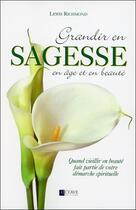Résumé:
What is work, truly? In its widest sense, work is not just a job. It is the sum of all our purposeful activities. Seen in this light, work is our whole life. In a continuation of his national bestseller, Work as a Spiritual Practice, Lewis Richmond's latest effort, A Whole Life's Work,... Voir plus
What is work, truly? In its widest sense, work is not just a job. It is the sum of all our purposeful activities. Seen in this light, work is our whole life. In a continuation of his national bestseller, Work as a Spiritual Practice, Lewis Richmond's latest effort, A Whole Life's Work, explores the many facets of work as a means to cultivate inner life and contribute to the developing consciousness of all humanity. A Whole Life's Work defines eight important modes of work -- the Earner, the Hobbyist, the Creator, the Monk, the Helper, the Parent, the Learner, and the Elder -- along with their corresponding eight modes of inner work: Precepts, Vitality, Patience, Calm, Equanimity, Giving, Humility, and Wisdom. These inner modes are drawn from the author's Buddhist training, but in some form they can be found in most other spiritual traditions, demonstrating the recognition throughout history that our whole life's work has inner as well as outer dimensions. Here Lewis Richmond addresses a primary struggle of contemporary life: how to strike a balance between achievement and ambition on the one hand, and happiness and fulfillment on the other. Whether we are professionals, artists, hobbyists, parents, or students, Lewis helps us recognize the larger picture, too -- our contributions and responsibilities to the wider consciousness of the planet. Through teaching stories, spiritual exercises, and interviews, A Whole Life's Work provides an invaluable roadmap toward the ultimate reconciliation of outer livelihood with inner life, so that when we have grown old we can look back and say: I did the best I could, what I did counted, I am satisfied.















